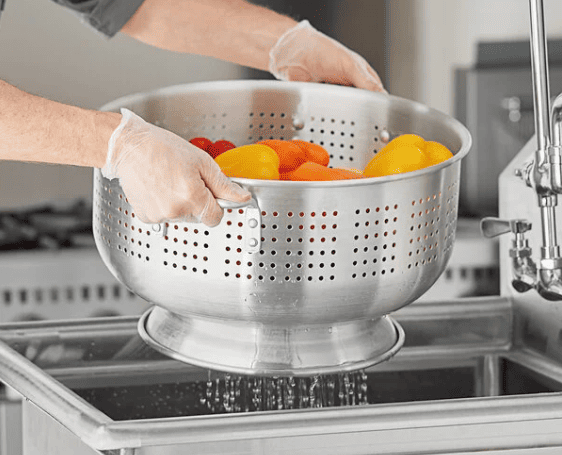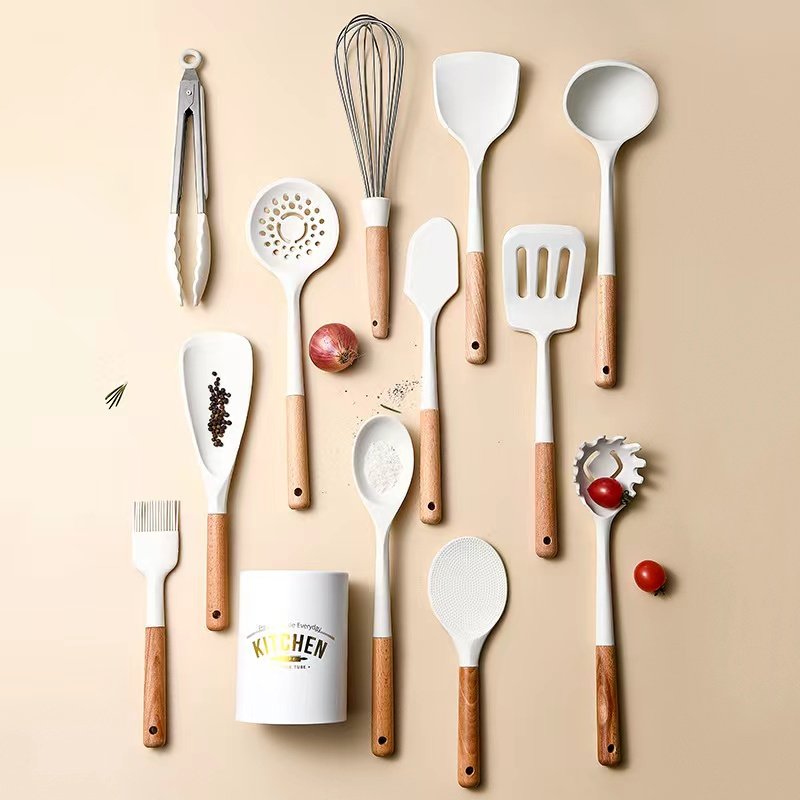Many people use colanders and strainers interchangeably, but they are not the same. Using the wrong tool can lead to frustration, especially when trying to prepare food quickly. Understanding the key differences between colanders and strainers will ensure you use the right tool for every task, enhancing your cooking experience.
Colanders and strainers both serve the purpose of draining or separating, but they are designed differently. Colanders have larger holes for draining liquids from foods like pasta, while strainers feature finer mesh for separating smaller particles or sifting.
In the following sections, we’ll delve deeper into the uses of each tool and explore when to choose a colander versus a strainer.
Table of Contents

What is a Colander?
A colander is a kitchen utensil primarily used for draining liquids from foods like pasta, vegetables, and fruits. It typically features large holes or slots to allow liquid to drain quickly. Colanders are often made from materials such as stainless steel, plastic, or ceramic, and they come in various sizes and shapes. They are most commonly found in kitchens, whether used for rinsing fruits, draining pasta, or washing vegetables.
Colanders are commonly made of metal, plastic, or ceramic and are designed to drain excess water or liquid from food. They are ideal for larger items like pasta and salad.
Key Features of Colanders
A colander is designed with perforations or holes, allowing water or other liquids to pass through while holding food back. These holes are typically large, making colanders perfect for foods like pasta, potatoes, and leafy greens. Some colanders are designed with rubber or silicone feet, ensuring they stay stable while draining.
Best Uses for Colanders
Colanders are best used when draining large quantities of liquid from foods such as pasta, boiled potatoes, and washed vegetables. They are also useful for rinsing canned beans or draining canned vegetables. Some people even use colanders to serve salads or wash fruits before consumption.
Table: Different Types of Colanders and Their Features
| Type of Colander | Material | Best For | Size |
|---|---|---|---|
| Stainless Steel | Metal | Draining pasta, washing vegetables | Medium to large |
| Plastic | Plastic | Light tasks like rinsing beans or small fruits | Small to medium |
| Ceramic | Ceramic | Decorative serving, draining small amounts of food | Small to medium |
Colanders vs Strainer vs Sieve: Understanding the Terminology
While colanders and strainers might seem similar, a colander’s larger holes are better for quick drainage of larger items like pasta, whereas strainers, with their finer mesh, are meant for more delicate tasks such as filtering liquids or sifting dry ingredients.

What is a Strainer?
A strainer is a kitchen tool used to separate fine particles from liquids or to sift dry ingredients. Unlike a colander, which has large perforations, a strainer typically features a finer mesh to catch smaller particles. Strainers are often used in both savory and sweet cooking, from straining soups and sauces to sifting flour for baking.
Strainers are great for tasks like straining liquids such as soups or separating tea leaves. They come in various sizes, from small handheld versions to larger ones for bulk straining.
Types of Strainers
Strainers come in a wide variety of shapes and sizes, designed for different tasks. The most common types include fine mesh strainers, chinois strainers, and tea strainers. A fine mesh strainer is perfect for straining soups, sauces, and stocks, while a chinois (a type of strainer) is ideal for getting perfectly smooth purees or custards.
How to Use a Strainer Effectively
Strainers are generally used for separating solid particles from liquids. For example, you can use a fine mesh strainer to remove bones, seeds, or skin from sauces, stocks, or soups. For dry ingredients, strainers are often used to sift flour or powdered sugar to remove lumps.
Table: Comparing Strainers for Different Uses
| Strainer Type | Best For | Mesh Size | Common Uses |
|---|---|---|---|
| Fine Mesh Strainer | Liquid separation, sifting flour | Fine | Straining soups, sifting dry ingredients |
| Chinois Strainer | Fine filtering of liquids | Very Fine | Smooth sauces, purees, custards |
| Tea Strainer | Tea brewing | Medium | Straining tea leaves |
What is a Strainer Used for in Cooking?
Strainers are versatile tools and can be used for various tasks like straining tea, filtering broths, and sifting flour. Their mesh design allows them to filter out unwanted solid particles from liquids or separate dry ingredients like flour, making them essential for bakers and cooks alike.
Are Colanders and Strainers the Same Thing?
While colanders and strainers may seem interchangeable because they both help in separating solids from liquids, their functions and designs are actually quite different. A colander is designed with large holes, making it ideal for draining large quantities of liquid from food items like pasta. In contrast, strainers have finer mesh and are more suitable for delicate tasks like sifting flour or straining small particles from liquids.
Colanders are typically used for larger tasks like draining pasta or washing vegetables, while strainers are more suitable for fine sifting and separating small particles from liquids.
Functionality vs Design
The main difference between a colander and a strainer lies in their design. Colanders feature larger holes which make them efficient for draining foods like pasta, vegetables, or fruit. On the other hand, strainers are designed with finer mesh which is ideal for catching smaller particles making them the go-to choice for sifting dry ingredients or straining liquids.
Can You Use a Colander Instead of a Strainer?
While you can use a colander for some straining tasks such as removing large debris from liquid it is not effective for finer straining tasks. For instance if you’re trying to strain a sauce or sift flour a strainer will perform the task much better due to its finer mesh.
Table: Colander vs Strainer vs Sieve Comparison
| Tool | Mesh Size | Best Uses | Ideal For |
|---|---|---|---|
| Colander | Large holes | Draining pasta washing vegetables | Quick drainage of larger foods |
| Strainer | Fine mesh | Straining liquids sifting dry ingredients | Sifting flour straining tea |
| Sieve | Very fine mesh | Sifting powders fine liquids | Flour powdered sugar custard |
Which is Better for Draining Pasta: A Strainer or a Colander?
When it comes to draining pasta a colander is generally the better tool. Its large holes allow the water to drain quickly and efficiently without losing any pasta. A strainer on the other hand is better suited for more delicate tasks like straining tea or separating smaller particles from a liquid.
A colander is typically the better option for draining pasta because of its larger holes allowing water to escape quickly without losing any food.
Why Colanders Are Ideal for Pasta
A colander is designed with the specific function of draining large amounts of liquid quickly. This makes it perfect for tasks like draining pasta which needs to be done quickly without any loss of food. Its structure ensures that excess water is effectively removed without taking the pasta along with it.
Strainer vs Colander for Pasta
While you can technically use a strainer for pasta it is not ideal. The fine mesh will trap the pasta making it difficult to remove and may even cause the pasta to stick. A colander’s larger holes are much better suited to the task ensuring you can drain the pasta quickly and without fuss.
Table: Comparing Strainers and Colanders for Pasta
| Tool | Size of Holes | Best For | Why It’s Better for Pasta |
|---|---|---|---|
| Colander | Large holes | Draining pasta vegetables | Quickly drains large quantities of liquid |
| Strainer | Fine mesh | Sifting straining small particles | Not ideal for pasta traps food |
What is a Chino is Strainer?
A chinois strainer is a special type of fine-mesh strainer that’s often used in professional kitchens. It is ideal for making smooth sauces soups and purees. The chinois has a very fine mesh allowing it to filter out even the smallest particles leaving behind a silky smooth consistency.
A chinois strainer has an extra-fine mesh and is ideal for tasks that require a silky smooth texture like straining sauces or purées.
How to Use a Chinois Strainer
To use a chino is simply pour your sauce or liquid through the fine mesh into a container. You may need to use a spoon or pestle to help push the liquid through especially if the mixture is thick or chunky. The result will be a perfectly smooth sauce with no unwanted particles.








